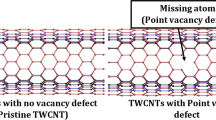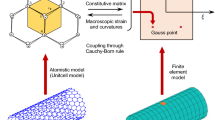Abstract
The present report outlines a probabilistic investigation of the temperature-dependent resonant frequency of various BNNT and CNT-based hetero-junctions and Van der Waals (VdW) heterostructures. Prior to performing the extensive atomistic simulations, the vibrational response of pristine SWCNT is validated by the values reported in the past literature. The responses determined in the present study are found in agreement (error within ≈ ± 8%) with the published literature. With the sufficient confidence in the results obtained by MD simulations, the further detailed analysis is carried out. In the preliminary analysis, the vibrational behaviour of the considered heterostructures is evaluated by taking into account the degree of heterogeneity, boundary conditions, and the inherent strain percentage in the system. To address the limitations of the heterostructures’ fracture and elastic behaviour, the structures are subjected to uniaxial tensile deformation, with the mechanical behaviour of the structures assessed based on the degree of heterogeneity. It is noticed that, the VdW heterostructures with the outer wall BNNT (10, 10) and inner wall CNT (5, 5) results in a slightly better (3%) resonant frequency than the DWCNT. The VdW heterogeneity has a positive impact on the failure strain of the structures; however, the fracture strength and Young’s modulus reduce drastically under the influence of the VdW heterogeneity. Following the preliminary analysis, the influence of stochastic variations in the temperature on the vibrational behavior of different hetero-nanotubes is assessed. In this regard, the artificial neural network (ANN) model is integrated with the random sampling-based MD simulations to characterize the temperature-dependent resonant frequencies of hetero-junctions and VdW heterostructures. The proposed machine learning-based framework performs the complete characterization of temperature-dependent resonant frequency of the considered heterostructures, which would otherwise remain unexplored due to the exorbitant nature of performing large-scale molecular dynamics simulations.









Similar content being viewed by others
References
Abdullah SS, Hosseini-Hashemi S, Hussein NA, Nazemnezhad R (2020) Effect of temperature on vibration of cracked single-walled carbon nanotubes embedded in an elastic medium under different boundary conditions. Mech Based Des Structures and Mach 50(5):1–26
Ahluwalia R, Lookman T, Saxena A, Cao W (2005) Domain-size dependence of piezoelectric properties of ferroelectrics. Phys Rev B 72(1):014112
Ajori S, Ansari R (2015) Vibrational characteristics of diethyltoluenediamines (DETDA) functionalized carbon nanotubes using molecular dynamics simulations. Physica B 459:58–61
Ajori S, Ansari R, Darvizeh M (2016) On the vibrational behavior of single-and double-walled carbon nanotubes under the physical adsorption of biomolecules in the aqueous environment: a molecular dynamics study. J Mol Model 22(3):62
Ajori S, Haghighi S, Parsapour H, Ansari R (2021) Fundamental frequency analysis of endohedrally functionalized carbon nanotubes with metallic nanowires: a molecular dynamics study. J Mol Model 27(11):1–10
Alian AR, Kundalwal SI, Meguid SA (2015) Multiscale modeling of carbon nanotube epoxy composites. Polymer 70:149–160
Ansari R, Ajori S (2015) A molecular dynamics study on the vibration of carbon and boron nitride double-walled hybrid nanotubes. Appl Phys A 120(4):1399–1406
Ansari R, Ajori S, Arash B (2012) Vibrations of single-and double-walled carbon nanotubes with layerwise boundary conditions: a molecular dynamics study. Curr Appl Phys 12(3):707–711
Ansari R, Ajori S, Ameri A (2015) On the vibrational characteristics of single-and double-walled carbon nanotubes containing ice nanotube in aqueous environment. Appl Phys A 121(1):223–232
Chandra Y, Mukhopadhyay T, Adhikari S (2020) Size-dependent dynamic characteristics of graphene based multi-layer nano heterostructures. Nanotechnology 31(14):145705
Dewapriya MAN, Rajapakse RKND, Dias WPS (2020) Characterizing fracture stress of defective graphene samples using shallow and deep artificial neural networks. Carbon 163:425–440
Dong J, Salem DP, Sun JH, Strano MS (2018) Analysis of multiplexed nanosensor arrays based on near-infrared fluorescent single-walled carbon nanotubes. ACS Nano 12(4):3769–3779
Eichler A, Moser J, Chaste J, Zdrojek M, Wilson-Rae I, Bachtold A (2011) Nonlinear damping in mechanical resonators made from carbon nanotubes and graphene. Nat Nanotechnol 6(6):339–342
Filatov O, Soldatenko S, Soldatenko O (2019) The determination of temperature stability of silver nanotubes by the molecular dynamics simulation. Appl Nanosci 9(5):853–857
Fu C, Chen Y, Jiao J (2007) Molecular dynamics simulation of the test of single-walled carbon nanotubes under tensile loading. Sci China Ser E 50(1):7–17
Gupta KK, Mukhopadhyay T, Roy A, Dey S (2020) Probing the compound effect of spatially varying intrinsic defects and doping on mechanical properties of hybrid graphene monolayers. J Mater Sci Technol 50:44–58
Gupta KK, Mukhopadhyay T, Roy A, Roy L, Dey S (2021a) Sparse machine learning assisted deep computational insights on the mechanical properties of graphene with intrinsic defects and doping. J Phys Chem Solids 155:110111
Gupta KK, Mukhopadhyay T, Roy L, Dey S (2021b) Hybrid machine learning assisted quantification of the compound internal and external uncertainties of graphene: towards inclusive analysis and design. Mater Adv 3:1160–1181
Humphrey W, Dalke A, Schulten K (1996) VMD: visual molecular dynamics. J Mol Graph 14(1):33–38
Jiang W, Zeng Y, Qin Q, Luo Q (2016) A novel oscillator based on heterogeneous carbon@ MoS 2 nanotubes. Nano Res 9(6):1775–1784
Jinkins KR, Chan J, Jacobberger RM, Berson A, Arnold MS (2019) Substrate-wide confined shear alignment of carbon nanotubes for thin film transistors. Adv Electro Mater 5(2):1800593
Kundalwal SI, Meguid SA (2017) Multiscale modeling of regularly staggered carbon fibers embedded in nano-reinforced composites. Eur J Mech-A/Solids 64:69–84
Li H, Jiang L, Feng Q, Huang Z, Zhou H, Gong Y, Kuang Y (2019) Ultra-fast transfer and high storage of Li+/Na+ in MnO quantum dots@ carbon hetero-nanotubes: appropriate quantum dots to improve the rate. Energy Storage Mater 17:157–166
Liu Z, Dai S, Wang Y, Yang B, Hao D, Liu D, Huang J (2020) Photoresponsive transistors based on lead-free perovskite and carbon nanotubes. Adv Func Mater 30(3):1906335
Mahata A, Mukhopadhyay T, Adhikari S (2016) A polynomial chaos expansion based molecular dynamics study for probabilistic strength analysis of nano-twinned copper. Mater Res Expr 3(3):036501
Mukhopadhyay T, Mahata A, Dey S, Adhikari S (2016) Probabilistic analysis and design of HCP nanowires: an efficient surrogate based molecular dynamics simulation approach. J Mater Sci Technol 32(12):1345–1351
Pan H, Feng YP, Lin J (2008) Boron nitride and carbon double-wall hetero-nanotubes: first-principles calculation of electronic properties. Nanotechnology 19(9):095707
Plimpton S (1995) Fast parallel algorithms for short-range molecular dynamics. J Comput Phys 117(1):1–19
Qian ZS, Shan XY, Chai LJ, Ma JJ, Chen JR, Feng H (2014) DNA nanosensor based on biocompatible graphene quantum dots and carbon nanotubes. Biosens Bioelectron 60:64–70
Roy A, Gupta KK, Naskar S, Mukhopadhyay T, Dey S (2021) Compound influence of topological defects and heteroatomic inclusions on the mechanical properties of SWCNTs. Materials Today Commun 26:102021
Sedighi HM (2020) Divergence and flutter instability of magneto-thermo-elastic C-BN hetero-nanotubes conveying fluid. Acta Mech Sin 36(2):381–396
Sedighi HM, Malikan M, Valipour A, Żur KK (2020) Nonlocal vibration of carbon/boron-nitride nano-hetero-structure in thermal and magnetic fields by means of nonlinear finite element method. J Comput Design Eng 7(5):591–602
Talukdar K, Mitra AK (2011) Molecular dynamics simulation study on the mechanical properties and fracture behavior of single-wall carbon nanotubes. In: Yellampalli S (ed) Carbon nanotubes - synthesis, characterization, applications, IntechOpen, London. https://doi.org/10.5772/20363
Tersoff J (1988) Empirical interatomic potential for silicon with improved elastic properties. Phys Rev B 38(14):9902
Tiangtrong P, Thamwattana N, Baowan D (2016) Modelling water molecules inside cyclic peptide nanotubes. Appl Nanosci 6(3):345–357
Wang Q, Arash B (2014) A review on applications of carbon nanotubes and graphenes as nanoresonator sensors. Comput Mater Sci 82:350–360
Wang Y, Wu H, Liu Z, Zhao H, Huang L, Wang Q, Zhang Y (2019) Tailoring sandwich-like CNT@ MnO@ N-doped carbon hetero-nanotubes as advanced anodes for boosting lithium storage. Electrochim Acta 304:158–167
Yang H, Zhang Z, Zhang J, Zeng XC (2018) Machine learning and artificial neural network prediction of interfacial thermal resistance between graphene and hexagonal boron nitride. Nanoscale 10(40):19092–19099
Zhang YY, Wang CM, Tan VBC (2009) Assessment of Timoshenko beam models for vibrational behavior of single-walled carbon nanotubes using molecular dynamics. Adv Appl Math Mech 1(1):89–106
Acknowledgements
AR and KKG acknowledge the financial support from MOE, Govt. of India, during the research work.
Author information
Authors and Affiliations
Corresponding author
Ethics declarations
Conflict of interest
The authors declare that they have no known competing financial interests or personal relationships that could have appeared to influence the work reported in this paper.
Additional information
Publisher's Note
Springer Nature remains neutral with regard to jurisdictional claims in published maps and institutional affiliations.
Supplementary Information
Below is the link to the electronic supplementary material.
Rights and permissions
About this article
Cite this article
Roy, A., Gupta, K.K. & Dey, S. Probabilistic investigation of temperature-dependent vibrational behavior of hetero-nanotubes. Appl Nanosci 12, 2077–2089 (2022). https://doi.org/10.1007/s13204-022-02487-6
Received:
Accepted:
Published:
Issue Date:
DOI: https://doi.org/10.1007/s13204-022-02487-6




